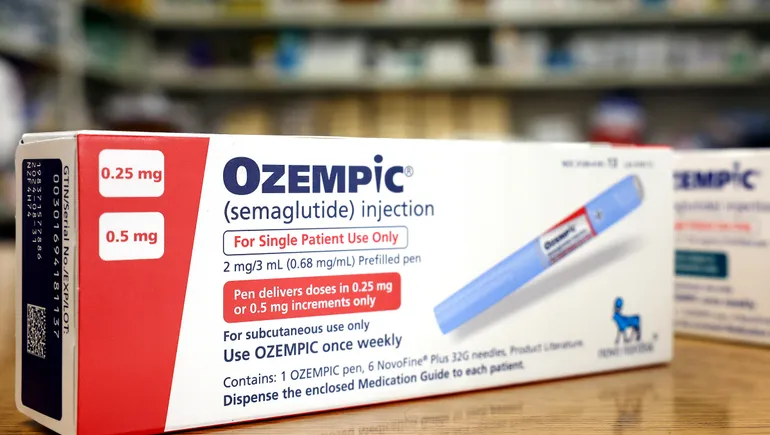How a new recipe can help food win in an Ozempic world

The following op-ed is written by Scott Bowman, a managing director at Clareo and the co-founder of the NOURISH Movement and Wiles Kase, a senior consultant at Clareo.
The stunning rise of anti-obesity (GLP-1 agonist) medications has caught the food industry flat-footed. Walmart’s U.S. CEO, John Furner, signaled the impact when he told Bloomberg that people on weight loss medications are buying less food.

Optional Caption
Permission granted by Scott Bowman
Retailers and food manufacturers are feeling the effects as well and investors are growing concerned about the impact, given reports that conclude nearly 7% of the U.S. population will be on them by 2035.
So far, the dominant narrative is that food loses out in the battle for better health, but the question remains whether food can actually win in an Ozempic world.

Optional Caption
Permission granted by Wiles Kase
The GLP-1 craze can accelerate the food as medicine movement, but the food industry will need a new recipe for growth.
A perfect storm is creating an imperfect solution
Over 40 million people in the U.S. live with diabetes and over 40% of the population is obese, up from 30% just two decades ago. With the introduction of GLP-1s to the market, it can reduce up to 15% of one’s body weight and reduce around 1.5% or more in A1c, which correlates directly with healthcare costs.
Pharma companies poured capital into their familiar DTC playbook — spending on GLP class drugs rose from $8.9B in 2018 to $35B in 2022. Influencer-driven social media marketing has also accelerated their popularity, with one study showing TikTok videos under #Ozempic received over 70 million views and drove over a quarter million shares.
However, this perfect storm has created an imperfect solution. On the surface, the drugs themselves look like a great trade: a quick-fix solution to society’s out-of-control obesity and diabetes problems, in place of the more complicated and long-term solution of addressing underlying health through what and how people eat. But what are we trading?
Drugs like Ozempic cost, on average, more than $10,000 per consumer per year, only slightly less than the annual cost per consumer of eating a healthy diet. Meanwhile, multiple studies have shown that once a consumer goes off these medications, they regain 2/3 of the weight they had lost while on the drugs.
When consumers are on these drugs, some experience everyday side effects like gastrointestinal problems, nausea and muscle wasting – and more severe ones, like pancreatitis and bowel obstructions.
Many leaders have pointed to the fact that the study design for many of these medications assumed a healthy diet and lifestyle, which may not always be the case.
A catalyst for food innovation
We have a condition caused by diet, that can be solved through diet with no negative side effects. Instead, we’re using expensive medications with potentially dangerous side effects, temporary results, no long-term studies, and which don’t address the underlying condition.
We’re choosing to pay for expensive band-aids instead of solving the real problem. Food has been vilified — at times, rightly — as being the problem, but food can also be part of the solution:
Food as an alternative to GLP-1s. Researchers are finding that beta-glucan and other fermentable fibers (found in oats, rye and barley) can turn on GLP-1 in the same way the drugs can, improving insulin sensitivity, lowering blood pressure, and increasing satiation between meals. In effect, they can mimic the effects the drugs would have on the body.
Food as a support to GLP-1s. Foods can also be designed and paired as companions to improve outcomes and reduce the side effects of GLP-1 drugs. Food guidelines include prioritizing complex carbohydrates and lean proteins with each meal, avoiding fatty foods, and increasing fruit and vegetable intake. Certain food manufacturers like Nestlé see early potential in aligning products like their Boost and Optifast nutritional drinks to address these needs. Opportunities also exist to pair foods with lifestyle change programs, such as Lark.
Food as an offboarding (‘step-down’) therapy. Most therapeutic interventions with GLP-1s are time-limited, lasting from a few months to a year. What happens when consumers go off them, and how can food help reduce the likelihood of weight regain and reversal of the benefits? Consumers and the providers that support them need to see a path to sustainable change, not just a quick fix.
An innovation playbook is needed
Food as medicine programs have the potential to deliver powerful ROI. Food companies just need to employ a fresh approach.
Design food programs to go after the food as medicine opportunity, using the vast public and private sector funding to innovate in categories such as medically tailored meals, functional snacking, and targeting GLP-1 needs. Food retailers also have real potential to connect their pharmacies with retail activations and medically tailored grocery programs tied to filtered (directed) spend programs..
Leverage cross-sector partnerships with players targeting anti-obesity and chronic condition management, like Vida Health; food as medicine players like Season Health and weight management companies like Weight Watchers, which is beginning to envision food programs as a complement to their GLP-1 programs; and employers, who have a vested interest in lowering costs.
Reimagine food product design by leveraging upstream partnerships with players like Brightseed, which is now using its Forager AI platform to create ingredients such as bioactive fibers, as well as ingredient production platforms like Shiru, and bioinformatics players like Canomiks to design and validate new formulations for health conditions.
Obesity and diabetes are the right problems for food to pursue. But needles alone are not the solution; we need more (and smarter) forks, too. The GLP threat to food is real, but this near-term challenge can be a catalyst for advancements in food’s role in health. Let’s use this opportunity to channel our concern into innovation.
Source: fooddive.com

